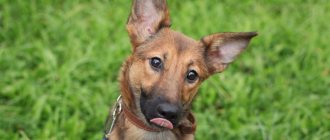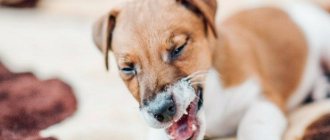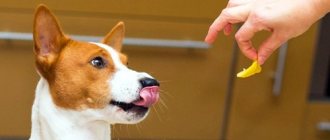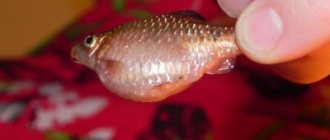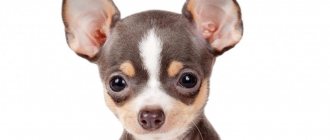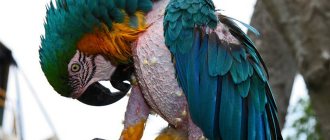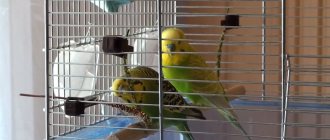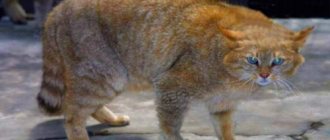- home
- Parrot
- Treatment
05/11/2019 Owners of small and medium-sized parrot breeds need to especially carefully monitor the health of their feathered pet. A situation where a parrot is trembling can occur for various reasons - completely harmless or dangerous. Typically, this symptom is a result of stress in the body for various reasons.
Trembling is a sign of stress
When you want to have a parrot, you need to evaluate the possibility of placing it. You cannot put the bird's cage in a noisy room, for example, he will be frightened by loud noises or constant attention. Yes, parakeets are social, but interaction with humans should not be overwhelming. Especially in the first weeks of a bird’s life in a new place, you should not be surprised if the parrot is shaking. During the adaptation period, you need to take care of him and not overload him with attention.
Other sources of stress include other pets and noisy children. Budgerigars will be especially worried; they are small in size. It is better to place the bird in a quiet room, only gradually accustoming it to the company of other inhabitants of the house. But even a long-tamed parrot can cluck if a lot of people come - they don’t like such concentrated attention.
What to do, how to help your pet
There are several tips that you can use if your bird’s condition does not cause concern, and the reason for his trembling and pouting is not due to illness:
- wrap a frozen pet in a warm, soft towel and gently hold it close to you, turn on a heating lamp - after a while it will warm up and stop shaking;
- if the parrot is trembling due to stress or fear, eliminate the cause of this condition and give the bird time to calm down, talk to it gently, and give it a treat.
All other conditions require medical supervision.
Disease Prevention
It is important to provide your pet with the right living conditions. Everything he has the opportunity to come into contact with must be safe for his health and life.
- For breeds as delicate and small as the budgerigar, it is important that food is always available. Make sure that the products are always of high quality and fresh, and that the diet is varied.
- Monitor air temperature and humidity. The microclimate in your room with birds should be optimal for life (22-25°C).
- Protect your pet from stress.
- Adjust daylight hours, clearly delineating the time of wakefulness and sleep. Lighting lamps and thick fabric will help you with this, with which you can cover the cage with the parrot when it is time for him to rest.
- Remove poisonous plants from the room that the bird can taste, do not place it in the kitchen, do not smoke in the same room as it, and make sure that it does not have access to toxic substances.
- Take care of the hygiene of your pet’s home and himself: regularly clean the tray of the cage, wash and disinfect all equipment.
- Both overeating, which can cause obesity, and undernutrition, which leads to exhaustion, are unacceptable. In the latter case, you need to force-feed the pet with nutritional masses from a syringe without a needle.
- A pet can get an infection from a sick person, so they should limit contact with each other until they have fully recovered.
A shaking and ruffled parrot needs your care and immediate response. By noticing the disease in time and starting to treat it, you give your pet every chance to live a long and happy life with you. Don't deprive him of this opportunity.
Shivering means he's hypothermic
If your pet is trembling, one of the reasons may be temperature discomfort. The natural habitat is tropical or subtropical, so if the owner is negligent, they can freeze. Cold, drafts and lack of light are contraindicated for parrots; this will lead to a deterioration in their health. If in cold weather you do not place a lamp with ultraviolet light next to the cage, it is not surprising that the parrot becomes ruffled and trembles.
During sleep, the cage should be covered with thick, breathable fabric, and a lamp should be placed nearby. You cannot place the cage near heating elements unless necessary - the feathered pet does not need overheating.
Why is he shaking his head?
Your pet may shake their head for many reasons:
- Looking for someone.
- Be sick.
- Particles of grains remained in the crop.
- Presence of a tracheal mite.
To exclude these diseases, it is necessary to conduct a visual inspection for damage and palpate the bird’s body: wings, legs, torso. A healthy individual shakes its head for reasons of anxiety, fear or curiosity. The inflammatory process may be accompanied by nausea and diarrhea.
The grains are stuck in the crop
Cockatiels and budgies should not be fed large, unmilled grains. If swallowed, the bird may not completely separate them, which will cause pain in the crop. The stuck piece can be felt with light movements. Ignoring the symptom leads to the death of the pet. Trembling in the body is sometimes accompanied by food coming out of the beak, which can occur in case of overeating.
Presence of a tracheal mite
The tracheal mite is a parasite that lives in the upper respiratory tract of birds and feeds on the contents of the secretion, affecting the respiratory system: trachea, larynx. As the mite grows, it limits access to oxygen. When trying to breathe, the cockatiel begins to shake its head from side to side.
It is necessary to take a smear for parasites and analyze the droppings. After receiving the result, the doctor prescribes antiparasitic drugs if necessary. The treatment process lasts 2 weeks. The first symptoms of the onset of the disease are wheezing, coughing and slight loss of voice. The symptom of trembling can also cause other parasitic diseases that appear against the background of vitamin deficiency.
If your pet continues to tremble for 24 hours, you should take your cockatiel to the veterinarian.
Nausea
Nausea and tremors in birds appear due to poor nutrition, failure to observe meal times, the presence of difficult-to-digest food components, scarcity of vitamins in the feed, and monotony of the diet. If the symptom is not cured in time, then gradually the movements become slow, the bird is passive, apathetic to everything, the pet often shakes its head, trying to get rid of the unpleasant symptom on its own.
Nausea can be the cause of poisoning, symptoms of parasitic diseases, skull trauma, and pathological processes of the digestive system. In such cases, the cockatiel needs care and a special treatment method.
Tumor of the swallowing organs
The tumor is a rare disease of birds, which during the growth process blocks access to air. During life, malignant cancer releases toxic substances into the blood, and during decay, toxic compounds that cause inflammatory processes, increased body temperature, which results in chills. Small tumor-like growths interfere with the development of vocal melody, and the individual begins to shake its head.
The process manifests itself in the form of symptoms: body trembling, difficulty swallowing, tickling.
A tumor of the respiratory organs is caused by inflammatory processes. In this case, it is necessary to apply dry heat to the sore spot and give the bird only warm water to drink. If the procedures are performed frequently, the swelling will be relieved quickly. Impaired swallowing is a dangerous symptom; if it is not eliminated, the pet will die from suffocation.
Injury
If the parrot has suffered a spinal injury, where the nervous system is involved, the initial symptoms will appear in the form of head twitching. If the parrot experiences pain, then it is necessary to find out where the damage occurred.
Trembling as a symptom of vitamin deficiency
If your budgie is constantly trembling, the cause may be an unbalanced diet. Grain-based food alone is not enough; it is worth taking a closer look at nutritional supplements sold in pet stores. Vitamin deficiency is dangerous for birds; their general condition may worsen and feathers may fall out.
In the summer, you can feed your parrot berries and fruits, which they love very much. It is important not to overfeed your pet, for example, 2-3 grapes in 2-3 days will be enough. With vitamin deficiency, the parrot may feel lethargic and often closes its eyes during the day or even sleeps.
Why does the wings and tail tremble?
Based on the criteria, the cause of the symptom of trembling in the body and tail and pathological symptoms are determined.
- Severe anxiety.
- Poor living conditions.
- Low sanitary standards.
- Parasitic diseases.
- Inappropriate microclimate (too hot or cold in the room).
- Bacterial, viral infections.
- Inflammatory processes.
- Lack of attention, sadness, loneliness.
- Low quality food.
- Jar of Hearts.
If a budgerigar hides its head under its wing, which can cause chills and inflammation, it is necessary to warm the bird as soon as possible. If the inflammation process is not treated, the pet will die suddenly.
Change of home
A change of environment is a tragic event for a pet. A new room, loud sounds, people around who pay frequent attention - everything frightens the baby. This is manifested by trembling in the body. In order for your pet to quickly get used to the atmosphere, you need to leave him alone in the cage for several hours. Then gradually accustom him to yourself, by talking, feeding, and affectionate words.
Change of owner
Corella may tremble not only due to cold and pathological reactions in the body. A change of owner comes as a blow to the bird. Birds have short-term memory and forget the old owner within 2 months. In order not to frighten the bird, visit it once every three hours the first day; the next day you need to visit the cage more often.
In quiet conversations, use a friendly intonation and affectionate phrases, which can have a positive effect on your pet’s mood.
Loud sounds
To quickly adapt your budgerigar, you should not turn on the equipment at medium or loud power: TV, tape recorder, speakers, telephones. A bird can die from fear, since stressful situations are accompanied by an increase in heart rate and the release of the fear hormone - adrenaline - into the blood, as a result of which the pulse increases more. The heart muscle cannot withstand heavy stress.
It is very difficult to identify symptoms of increased heart rate; in order to prevent disastrous consequences, you should not make sudden movements near the cage or talk loudly.
Corella loves peace and quiet, do not turn on the equipment at medium volume.
Children
A pet in the house is a joyful reason for children to check, touch, and stroke a feathered pet, which is extremely undesirable. Enthusiastic screams and emotions can stir up peace and cause injury to the cockatiel. Not allowing children to see a new bird can cause children to cry and even become hysterical. To please everyone and not spoil the calm, warm atmosphere in the family before the performance.
Before introducing the parrot, children must be warned that from now on they will speak in a quiet voice, play only calm games, otherwise the bird will fly away to other obedient, peaceful children. Symptoms of fear manifest themselves in the form of trembling in the body, adopting a sedentary posture. The pet does not like noisy environments. The cage should be spacious and neat.
The pet will not tremble provided that sanitary standards are constantly followed.
Poor nutrition
You should know that birds have a fast metabolism. Micronutrients must be supplied regularly. The diet should contain: ground cereals with the addition of dry cereals, fruits, vegetables, feed. The cockatiel will tremble in the cage if not fed enough.
Trembling is a manifestation of illness
When you are sick, one of the symptoms may be trembling. If your pet exhibits at least one of the following signs, you should contact your veterinarian:
- Stomach upset or loss of appetite.
- Lethargy alternating with a noisy state.
- Shortness of breath, the parrot has difficulty sitting on the perch, the tail is shaking. By the way, this is exactly how pregnant females behave.
- Makes unusual sounds.
- The parrot itches, tries to pull out its feathers with its beak or shakes its wings. The cause may be parasites that have settled on the bird’s body.
- He flies around the cage screaming, even if he is regularly let out to fly around the room.
To minimize the development of disease in parrots, you should regularly clean the cage, provide opportunities to fly, and provide comfort. It is not recommended to treat the bird yourself - you may miss time and the initial stage of the disease.
Prevention
If you properly care for your cockatiel or budgie and take all the necessary preventive measures, your pet’s life will turn into a fairy tale. The bird will feel great. To maintain order in the cage, it is necessary to clean the cage in a timely manner, use high-quality food, and not wake him up during sleep. To avoid the manifestation of pathogenic processes and symptoms, keep your pet clean and avoid noise. Trembling in a pet's body is the first sign of inflammation.
Previous
DiseasesWhy does a parrot constantly pluck its feathers and how to prevent it
Next
DiseasesAllergy to parrots in adults and children
Several signs that should alert a breeder
Parrots are very active and inquisitive, especially when flying around the room. If you let him out of your attention even for a few minutes, he will probably have time to crash. And the likely outcome is a fracture, which is indicated by lameness, the pet twitches its wings and tries not to move. You need to put him in a carrier and go to the veterinary clinic.
They can become infected with viral diseases from the owner, then they tremble and refuse to eat. During your own illness, it is better to wear a gauze bandage in the room with the parrot's cage. If a female parrot's tail is shaking, or rather, oscillating like a pendulum, this may indicate the imminent appearance of offspring. During this period, parrots need to be provided with comfortable conditions and closely monitor the condition of the female.
Possible cause: goiter blockage or tumor
If a bird frequently nods its head and closes its eyes, it is trying to free itself from food stuck in its crop. A pet may make frequent head movements if it has a tumor under its goiter. This can be easily determined by palpation. Ignoring this symptom will lead to the inevitable death of the pet.
Head movements are repeated by individuals experiencing nausea. The disease is accompanied by food falling out of the beak and regurgitation.
The bird shakes its tail
There are times when a parrot shakes its tail, breathes heavily and frequently. These symptoms may be caused by a respiratory illness. There may also be problems with the respiratory tract caused by a cold or tumor.
It is necessary to find out why the parrot's tail begins to shake. If a bird shakes its head and tail, this may mean that it has a headache. Pressure changes, injuries and stress are inherent in birds, just like humans.
A parrot can also shake from a minor injury. Often this movement appears reflexively in the bird and remains for life.
You can understand why a parrot shakes its tail by examining the cloaca. If the bird has no feathers in this place, the tail trembles, there are traces of inflammation, this means that there are problems with digestion, liver, or an oncological process has begun. In this case, you need to immediately visit a doctor.
There may be several reasons for the strange behavior of a feathered pet. It must be remembered that attention to the slightest change in the behavior of a bird can save the life of a pet.
Causes
A healthy parrot is very active. He often moves around the cage, plays and chirps. Any changes in its behavior indicate that the parrot is experiencing discomfort. Shivering in itself is not dangerous to the bird's health. It happens for a reason. If the bird sits silently in one place and shakes slightly, you must also pay attention to the appearance and behavior of the parrot. Trembling may be accompanied by the following symptoms:
- drowsiness;
- apathy;
- lack of appetite;
- the bird ruffled its feathers;
- eyes closed;
- disheveled appearance.
Unusual behavior and accompanying signs should never be ignored. The first step is to find out the cause and eliminate it as soon as possible.
If trembling occurs due to illness in your parrot, you should immediately contact a specialist.
It is also worth inspecting the cage and paying attention to bird droppings. Its absence, or, conversely, an excessive amount, changes in color, smell, structure, all this may indicate symptoms of the disease.
Causes not related to disease
Sometimes it happens that a completely healthy bird crests, trembles, and twitches its wings. This may be due to the following reasons:
- fear and stress;
- if the parrot freezes;
- with a lack of light;
- with a deficiency of vitamins and microelements.
STRESS IN THE PARROT // BUDGY PARROT TOSH // PARROT
Fear and stress
Fear usually arises during adaptation. The bird is in your home for the first time. New people, environments, sounds cause fear. To overcome the problem, do not frighten her with annoying attention, talk quietly and affectionately. Gradually the parrot will get used to it and everything will be fine.
The most common cause of stress is moving to a new apartment. The world familiar to the bird disappears, and a new, unexplored one appears. Give your pet the opportunity to get comfortable, and he will become the same.
The parrot is freezing
Birds are very sensitive to drafts and low temperatures. If your feathered pet is cold, turn on the table lamp.
Place it at a distance of half a meter from the cage, direct the light to the bottom. To retain heat, cover the remaining sides with thick fabric. But make sure your pet doesn't overheat.
The parrot is shaking
Lack of light
Lighting plays a very important role in the life of parrots. The fact is that they see ultraviolet light. Their perception of the world is brighter than human. With a small amount of ultraviolet rays, vision is impaired. Birds become lethargic, indifferent or irritable and angry. To increase sunlight, you can take the cage outside into the rays for an hour, an hour and a half, or walk with your pet using a special harness. You can also buy an ultraviolet lamp for additional lighting. It has already been proven in practice that with increasing ultraviolet radiation, the ability of parrots to reproduce increases.
Deficiency of vitamins and microelements
With monotonous feeding, vitamin deficiency may develop. Main features:
- lethargy and indifference;
- refusal to eat;
- the bird becomes ruffled and ruffled;
- the wings are trembling, the tail is tucked.
Trembling
To avoid such troubles, feed your pet a variety of foods, fresh fruits and vegetables are also needed.
Tracheal mite
This avian parasite causes a disease called sternostomosis. This disease affects the internal organs, larynx and trachea. Due to difficulties with swallowing and breathing, the parrot begins to actively shake its head and may even spit out grains. You can understand why a parrot shakes its body if you track other symptoms. At first, there is a partial loss of voice, coughing, and wheezing.
To accurately diagnose the disease, it is necessary to take a tracheal smear to check for parasites. A litter analysis is also needed. If the test shows the presence of mites, the veterinarian will prescribe treatment.
Important! The dosage of medications, the treatment itself and its duration are determined only by a specialist.
The prescribed medications are taken for about 2 weeks.
First flights
If a young parrot's wings are trembling, it may soon attempt to fly. Your parakeet should be allowed to fly indoors for two hours a day. He must fly under supervision in a safe environment. It is necessary to remove traumatic objects and avoid contact with other pets: rats, dogs, cats.
A lack of calcium can negatively affect a bird's ability to fly. Place mineral stones and sepia, cuttlefish shell in the cage.
Are there preventive measures?
Despite the fact that parrots are quite unpretentious to their living conditions, they still need comfort and coziness. The homeland of these birds is in countries with hot climatic conditions, for this reason they need the same conditions in captivity. Hypothermia can be fatal for this species of bird; in particular, they can develop kidney disease, which is difficult to treat.
As a preventive measure against the occurrence of any disease, it is to avoid drafts and sudden temperature changes, since they are delicate and sensitive creatures and are so easily susceptible to colds.
They can easily catch an infectious disease from their owners, so if you are sick, do not go near them under any circumstances, most likely they will get infected from you, and it will not be so easy to cure them.
And most importantly, you should not take on the treatment of a parrot on your own, because you will still not be able to provide highly qualified assistance, and you will miss out on valuable time. Due to the fact that the metabolism of parrots is carried out at a high speed, all diseases in them develop extremely quickly. So, don’t be late and save your pet!
First aid
The reason for the hunching, combined with trembling, may be adaptation to new conditions. A parrot becomes anxious if it has been transported from one room to another or transferred to a new cage. Perhaps he requires more attention. You need to talk to him. If a bird attacks a new toy or an object it does not understand, they are removed from the cage. If the next morning the parrot behaves adequately, this means that adaptation has been successful. If the apartment is cold, cover the cage with a towel, leaving a gap and pointing an incandescent lamp at it or the tray.
You can independently correct the situation when a bird develops hypovitaminosis or is poisoned by a delicacy not intended for perroque. The situation can be corrected by introducing a sorbent. Enterosgel is best suited. It is squeezed out of the tube, diluted with water, and 3-4 drops are added using a syringe without a needle. Activated carbon is given in a similar way. You should catch the bird in semi-darkness, covering the cage with a towel to reduce frightening. When trembling and ruffling are associated with injury, the parrot must be urgently taken to the clinic.
Enterosgel
What other symptoms should you be wary of?
In certain cases, contacting a specialist is simply vital. Delay threatens the parrot with death.
Let us highlight the following situations:
- fracture of limbs, tail or wing;
- the appearance of a bleeding wound on the body;
- signs of poisoning and digestive disorders;
- apathy, drowsiness;
- itching of the skin, excessive loss of feathers;
- partial or complete refusal to eat;
- convulsions;
- uncharacteristic cry, wheezing.
The sooner the diagnosis is made, the faster the bird’s condition will improve.
It will be useful for you to know what to do if your parrot constantly screams and creaks its beak.
